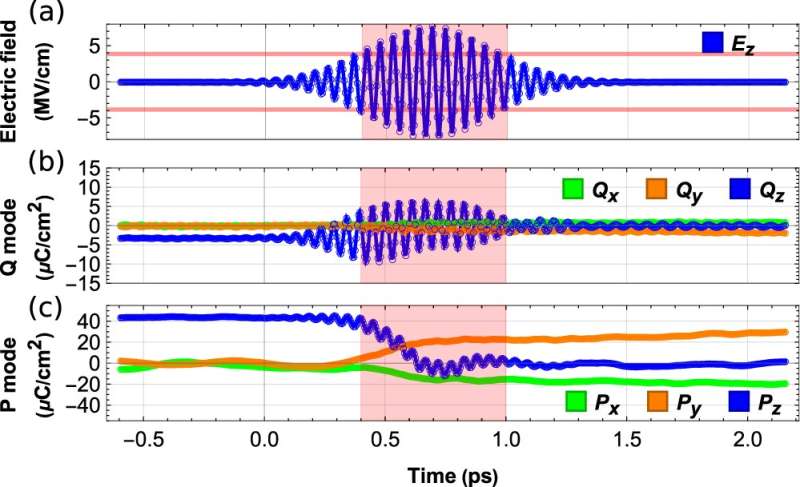Physicists discover light-induced mechanism for controlling ferroelectric polarization

By applying light, University of Arkansas physicists Peng Chen and Laurent Bellaiche have discovered a surprising mechanism for controlling ferroelectric polarization in a deterministic manner.
The finding, made possible by the application of ultrafast laser pulses, enriches fundamental physics research by advancing an understanding of the interactions between light and matter.
The research, published May 10 in Nature Communications, is also an important step toward the design and development of superior sensing and data storage in electronic devices.
Ferroelectric materials exhibit ferroelectricity and the ability to polarize spontaneously. Typically, researchers can manipulate and reverse this polarization by the application of an external electric field. Ultrafast interactions between light and matter are another promising route for controlling ferroelectric polarization, but until now researchers have struggled to achieve a light-induced, deterministic control of such polarization.
The researchers discovered a so-called "squeezing effect" in ferroelectric materials subject to femtosecond laser pulses. A femtosecond is one quadrillionth of a second. These pulses destroyed the polarization component that is parallel to the field's direction and created polarization components perpendicular to it. This squeezing effect allowed a deterministic control of the polarization by light.
"The applied terahertz pulse prefers to annihilate the polarization component along the field's direction, in favor of components perpendicular to the field associated with the pulses," said Peng, a research associate in Bellaiche's laboratory and the first author of the paper. "We consider this a novel terahertz phenomenon when light interacts with ferroelectric materials. Our findings should stimulate technical progress."
Chen and Bellaiche, Distinguished Professor of Physics, collaborated with colleagues Charles Paillard and Hongjian Zhao, former research associates in Bellaiche's laboratory, and Jorge Íñiguez at the Luxembourg Institute of Science and Technology. Researchers in Bellaiche's laboratory study various properties of different materials.
More information: Peng Chen et al, Deterministic control of ferroelectric polarization by ultrafast laser pulses, Nature Communications (2022). DOI: 10.1038/s41467-022-30324-5
Journal information: Nature Communications
Provided by University of Arkansas




















